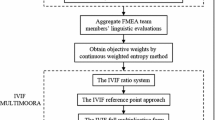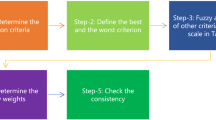Abstract
Failure mode and effects analysis (FMEA) is an effective reliability analysis technique used to identify and evaluate potential failures in systems, products, processes, and/or designs. In traditional FMEA, prioritization of failure modes is carried out by utilizing risk priority numbers (RPNs), which can be acquired by the multiplication of three risk factors: occurrence (O), severity (S) and detection (D). However, there are some inherent deficiencies in the conventional RPN method, which affect its effectiveness and thus limit its applications. In response, this paper introduces a new modified TOPSIS method, named intuitionistic fuzzy hybrid TOPSIS approach, to determine the risk priorities of failure modes identified in FMEA. Moreover, both the subjective and objective weights of risk factors are taken into consideration in the process of risk and failure analysis. A product example of the color super twisted nematic is presented at last to demonstrate the potential applications of the proposed approach, and the merits are highlighted by comparing with some existing methods.


Similar content being viewed by others
References
Atanassov KT (1986) Intuitionistic fuzzy sets. Fuzzy Set Syst 20(1):87–96
Boran FE, Genç S, Kurt M, Akay D (2009) A multi-criteria intuitionistic fuzzy group decision making for supplier selection with TOPSIS method. Expert Syst Appl 36(8):11363–11368
Bowles JB, Peláez CE (1995) Fuzzy logic prioritization of failures in a system failure mode, effects and criticality analysis. Reliab Eng Syst Safe 50(2):203–213
Braglia M, Frosolini M, Montanari R (2003) Fuzzy TOPSIS approach for failure mode, effects and criticality analysis. Qual Reliab Eng Int 19(5):425–443
Chang KH (2014) A more general risk assessment methodology using a soft set-based ranking technique. Soft Comput 18(1):169–183
Chang KH, Cheng CH (2010) A risk assessment methodology using intuitionistic fuzzy set in FMEA. Int J Syst Sci 41(12):1457– 1471
Chang KH, Wen TC (2010) A novel efficient approach for DFMEA combining 2-tuple and the OWA operator. Expert Syst Appl 37(3):2362–2370
Chang KH, Cheng CH, Chang YC (2010) Reprioritization of failures in a silane supply system using an intuitionistic fuzzy set ranking technique. Soft Comput 14(3):285–298
Chang KH, Chang YC, Tsai IT (2013) Enhancing FMEA assessment by integrating grey relational analysis and the decision making trial and evaluation laboratory approach. Eng Fail Anal 31:211–224
Chen SJ, Hwang CL, Hwang FP (1992) Fuzzy multiple attribute decision making: methods and applications. Springer, Berlin
Chin KS, Wang YM, Poon GKK, Yang JB (2009) Failure mode and effects analysis using a group-based evidential reasoning approach. Comput Oper Res 36(6):1768–1779
Du Y, Mo H, Deng X, Sadiq R, Deng Y (2014) A new method in failure mode and effects analysis based on evidential reasoning. Int J Syst Assur Eng Manag 5(1):1–10
Gargama H, Chaturvedi SK (2011) Criticality assessment models for failure mode effects and criticality analysis using fuzzy logic. IEEE Trans Reliab 60(1):102–110
Hadi-Vencheh A, Hejazi S, Eslaminasab Z (2013) A fuzzy linear programming model for risk evaluation in failure mode and effects analysis. Neural Comput Appl 22(6):1105–1113
Helvacioglu S, Ozen E (2014) Fuzzy based failure modes and effect analysis for yacht system design. Ocean Eng 79:131–141
Hwang CL, Yoon K (1981) Multiple attributes decision making methods and applications. Springer, Berlin
Kahraman C, Kaya İ, Şenvar Ö (2013) Healthcare failure mode and effects analysis under fuzziness. Hum Ecol Risk Assess 19(2):538–552
Kutlu AC, Ekmekçioğlu M (2012) Fuzzy failure modes and effects analysis by using fuzzy TOPSIS-based fuzzy AHP. Expert Syst Appl 39(1):61–67
Lin QL, Wang DJ, Lin WG, Liu HC (2014) Human reliability assessment for medical devices based on failure mode and effects analysis and fuzzy linguistic theory. Saf Sci 62:248–256
Liu HC, Liu L, Bian QH, Lin QL, Dong N, Xu PC (2011) Failure mode and effects analysis using fuzzy evidential reasoning approach and grey theory. Expert Syst Appl 38(4):4403–4415
Liu HC, Liu L, Liu N, Mao LX (2012) Risk evaluation in failure mode and effects analysis with extended VIKOR method under fuzzy environment. Expert Syst Appl 39(17):12926–12934
Liu HC, Liu L, Li P (2013a) Failure mode and effects analysis using intuitionistic fuzzy hybrid weighted Euclidean distance operator. Int J Syst Sci. doi:10.1080/00207721.2012.760669
Liu HC, Liu L, Lin QL (2013b) Fuzzy failure mode and effects analysis using fuzzy evidential reasoning and belief rule-based methodology. IEEE Trans Reliab 62(1):23–36
Liu HC, Liu L, Liu N (2013c) Risk evaluation approaches in failure mode and effects analysis: a literature review. Expert Syst Appl 40(2):828–838
Liu HC, Li P, You JX, Chen YZ (2014a) A novel approach for FMEA: combination of interval 2-tuple linguistic variables and grey relational analysis. Qual Reliab Eng Int. doi:10.1002/qre.1633
Liu HC, Ren ML, Wu J, Lin QL (2014b) An interval 2-tuple linguistic MCDM method for robot evaluation and selection. Int J Prod Res 52(10):2867–2880
Liu HC, You JX, Fan XJ, Lin QL (2014c) Failure mode and effects analysis using D numbers and grey relational projection method. Expert Syst Appl 41(10):4670–4679
Liu HC, You JX, Lin QL, Li H (2014d) Risk assessment in system FMEA combining fuzzy weighted average with fuzzy decision making trial and evaluation laboratory. Int J Comput Integr Manuf. doi:10.1080/0951192X.2014.900865
Mandal S, Maiti J (2014) Risk analysis using FMEA: fuzzy similarity value and possibility theory based approach. Expert Syst Appl 41(7):3527–3537
Merigó JM, Gil Lafuente AM (2008) The generalized adequacy coefficient and its application in strategic decision making. Fuzzy Econ Rev 13(2):17–36
Pillay A, Wang J (2003) Modified failure mode and effects analysis using approximate reasoning. Reliab Eng Syst Safe 79(1):69–85
Sang X, Liu X (2014) An analytic approach to obtain the least square deviation OWA operator weights. Fuzzy Sets Syst 240:103–116
Seyed-Hosseini SM, Safaei N, Asgharpour MJ (2006) Reprioritization of failures in a system failure mode and effects analysis by decision making trial and evaluation laboratory technique. Reliab Eng Syst Safe 91(8):872–881
Sharma RK, Kumar D, Kumar P (2005) Systematic failure mode effect analysis (FMEA) using fuzzy linguistic modelling. Int J Qual Reliab Manage 22(9):986–1004
Song W, Ming X, Wu Z, Zhu B (2013) Failure modes and effects analysis using integrated weight-based fuzzy TOPSIS. Int J Comput Integr Manuf 26(12):1172–1186
Song W, Ming X, Wu Z, Zhu B (2014) A rough TOPSIS approach for failure mode and effects analysis in uncertain environments. Qual Reliab Eng Int 30(4):473–486
Stamatis DH (2003) Failure mode and effect analysis: FMEA from theory to execution, 2nd edn. ASQC Quality Press, Milwaukee
Tay KM, Lim CP (2006) Fuzzy FMEA with a guided rules reduction system for prioritization of failures. Int J Qual Reliab Manage 23(8):1047–1066
Teoh PC, Case K (2005) An evaluation of failure modes and effects analysis generation method for conceptual design. Int J Comput Integ Manuf 18(4):279–293
Vahdani B, Tavakkoli-Moghaddam R, Mousavi SM, Ghodratnama A (2013) Soft computing based on new interval-valued fuzzy modified multi-criteria decision-making method. Appl Soft Comput 13(1):165–172
Vinodh S, Aravindraj S, Narayanan RS, Yogeshwaran N (2012) Fuzzy assessment of FMEA for rotary switches: a case study. TQM J 24(5):461–475
Wang YM, Chin KS, Poon GKK, Yang JB (2009) Risk evaluation in failure mode and effects analysis using fuzzy weighted geometric mean. Expert Syst Appl 36(2):1195–1207
Xu ZS (2005) An overview of methods for determining OWA weights. Int J Intell Syst 20(8):843–865
Xu ZS (2007) Intuitionistic fuzzy aggregation operators. IEEE Trans Fuzzy Syst 15(6):1179–1187
Xu ZS, Yager RR (2006) Some geometric aggregation operators based on intuitionistic fuzzy sets. Int J Gen Syst 35(4):417–433
Xu ZS, Yager RR (2008) Dynamic intuitionistic fuzzy multi-attribute decision making. Int J Approx Reason 48(1):246–262
Yager RR (1988) On ordered weighted averaging aggregation operators in multicriteria decision making. IEEE Trans Syst Man Cybern 18(1):183–190
Yang JP, Huang HZ, He LP, Zhu SP, Wen DW (2011) Risk evaluation in failure mode and effects analysis of aircraft turbine rotor blades using Dempster-Shafer evidence theory under uncertainty. Eng Fail Anal 18(8):2084–2092
Yeh TM, Chen LY (2013) Fuzzy-based risk priority number in FMEA for semiconductor wafer processes. Int J Prod Res 52(2):539–549
Zadeh LA (1965) Fuzzy sets. Inf Control 8(3):338–353
Acknowledgments
The authors sincerely thank the editor and the anonymous reviewers for their insights and helpful comments and suggestions which are very helpful in improving the quality of the paper. This work was supported by the Program for Professor of Special Appointment (Eastern Scholar) at Shanghai Institutions of Higher Learning and the National Natural Science Foundation of China (No. 71101087).
Author information
Authors and Affiliations
Corresponding author
Additional information
Communicated by V. Loia.
Rights and permissions
About this article
Cite this article
Liu, HC., You, JX., Shan, MM. et al. Failure mode and effects analysis using intuitionistic fuzzy hybrid TOPSIS approach. Soft Comput 19, 1085–1098 (2015). https://doi.org/10.1007/s00500-014-1321-x
Published:
Issue Date:
DOI: https://doi.org/10.1007/s00500-014-1321-x




